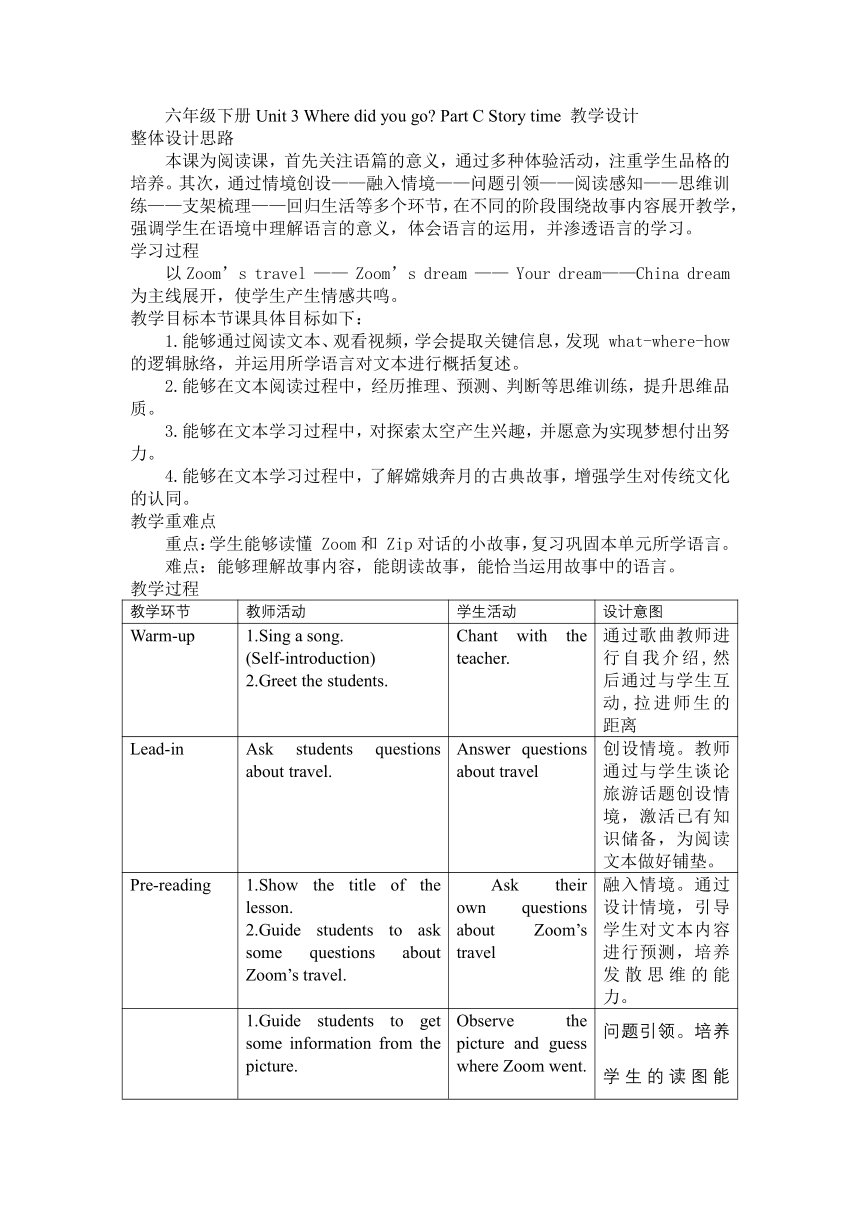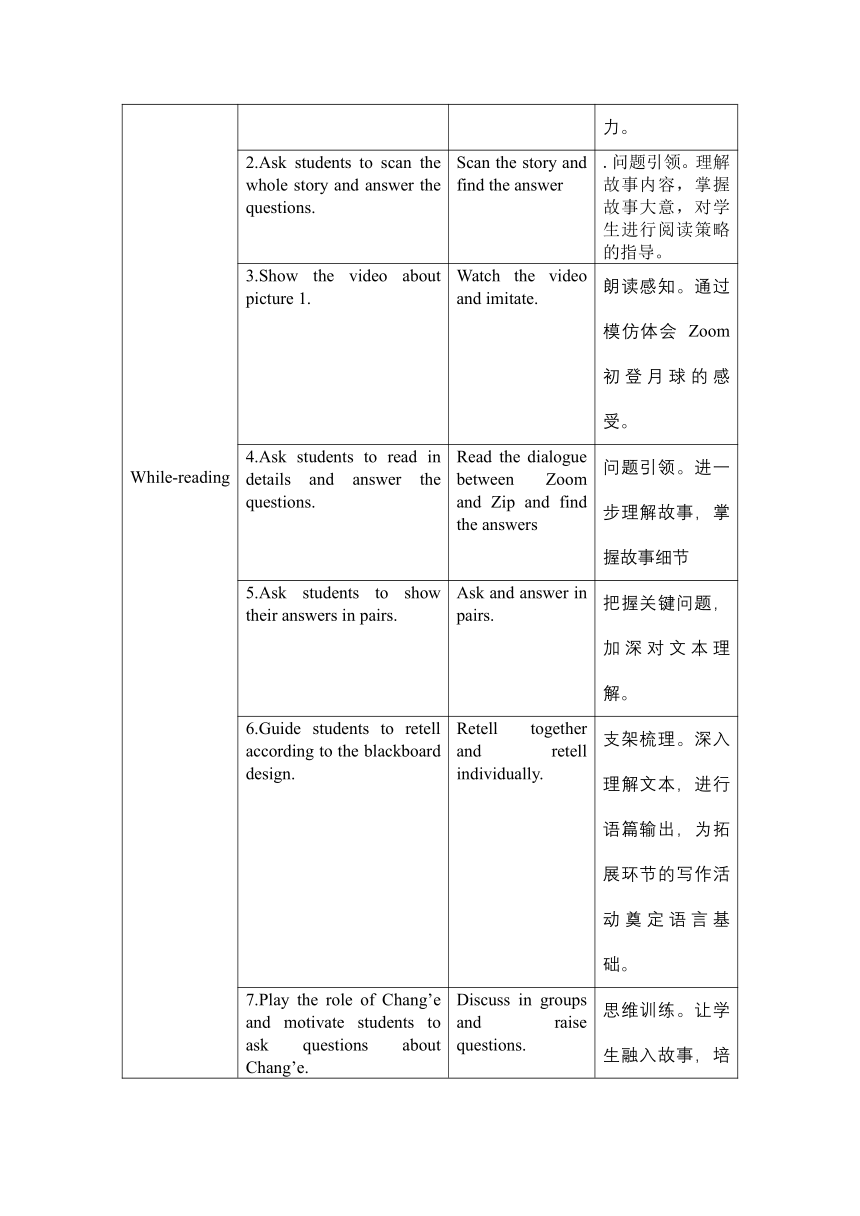Unit 3 Where did you go?Part C Story time 表格式教案
文档属性
| 名称 | Unit 3 Where did you go?Part C Story time 表格式教案 |

|
|
| 格式 | docx | ||
| 文件大小 | 22.6KB | ||
| 资源类型 | 教案 | ||
| 版本资源 | 人教版(PEP) | ||
| 科目 | 英语 | ||
| 更新时间 | 2024-06-24 10:03:25 | ||
图片预览


文档简介
六年级下册Unit 3 Where did you go Part C Story time 教学设计
整体设计思路
本课为阅读课,首先关注语篇的意义,通过多种体验活动,注重学生品格的培养。其次,通过情境创设——融入情境——问题引领——阅读感知——思维训练——支架梳理——回归生活等多个环节,在不同的阶段围绕故事内容展开教学,强调学生在语境中理解语言的意义,体会语言的运用,并渗透语言的学习。
学习过程
以Zoom’s travel —— Zoom’s dream —— Your dream——China dream为主线展开,使学生产生情感共鸣。
教学目标本节课具体目标如下:
1.能够通过阅读文本、观看视频,学会提取关键信息,发现 what-where-how的逻辑脉络,并运用所学语言对文本进行概括复述。
2.能够在文本阅读过程中,经历推理、预测、判断等思维训练,提升思维品质。
3.能够在文本学习过程中,对探索太空产生兴趣,并愿意为实现梦想付出努力。
4.能够在文本学习过程中,了解嫦娥奔月的古典故事,增强学生对传统文化的认同。
教学重难点
重点:学生能够读懂 Zoom和 Zip对话的小故事,复习巩固本单元所学语言。
难点:能够理解故事内容,能朗读故事,能恰当运用故事中的语言。
教学过程
教学环节 教师活动 学生活动 设计意图
Warm-up 1.Sing a song. (Self-introduction) 2.Greet the students. Chant with the teacher. 通过歌曲教师进行自我介绍,然后通过与学生互动,拉进师生的距离
Lead-in Ask students questions about travel. Answer questions about travel 创设情境。教师通过与学生谈论旅游话题创设情境,激活已有知识储备,为阅读文本做好铺垫。
Pre-reading 1.Show the title of the lesson. 2.Guide students to ask some questions about Zoom’s travel. Ask their own questions about Zoom’s travel 融入情境。通过设计情境,引导学生对文本内容进行预测,培养发散思维的能力。
While-reading 1.Guide students to get some information from the picture. Observe the picture and guess where Zoom went. 问题引领。培养学生的读图能力。
2.Ask students to scan the whole story and answer the questions. Scan the story and find the answer .问题引领。理解故事内容,掌握故事大意,对学生进行阅读策略的指导。
3.Show the video about picture 1. Watch the video and imitate. 朗读感知。通过模仿体会 Zoom初登月球的感受。
4.Ask students to read in details and answer the questions. Read the dialogue between Zoom and Zip and find the answers 问题引领。进一步理解故事,掌握故事细节
5.Ask students to show their answers in pairs. Ask and answer in pairs. 把握关键问题,加深对文本理解。
6.Guide students to retell according to the blackboard design. Retell together and retell individually. 支架梳理。深入理解文本,进行语篇输出,为拓展环节的写作活动奠定语言基础。
7.Play the role of Chang’e and motivate students to ask questions about Chang’e. Discuss in groups and raise questions. 思维训练。让学生融入故事,培养学生的发散思维
8.Ask students to think over the question and play the video about the whole story. Watch the video and think over the question “Why did Zoom see Chang’e ” Then read in roles. 整体听读故事,思考问题,并巩固所学内容。
9.Ask a question Observe the picture and find the answer. “Why did Zoom have such a dream ” 通过读图培养把握关键信息的能力。
Post-reading 1.Arrange the group work. Dream about their space travel and write it down. 拓展输出。根据板书对学生进行写作策略的指导,尝试语言输出。
2.Show a video of China’s exploration to the space. Enjoy the video and think about it. 学生了解中国航天事业进程,增强民族自豪感,体会太空的神秘与探索太空的兴趣
Homework Tell Zoom’s dream to others. Read more books about the space. Study hard for your dreams. 引导学生课下探索更多的太空知识,并为了自己的梦想努力学习。
PEP教材六年级下册Unit 3 C Story time 评测分析 1. Zoom had an unusual trip. Zoom 的特殊旅行,你想知道些什么?用 How,What,Where 提出你想知道的问题。 2. Watch and choose. Where did he go Zoom 去哪里旅行了? 3. Read and answer the questions. (仔细读第 3,4,5 幅图,在课文中圈出答案。) Q1: How was Zoom’s holiday It was ______. Q2: How did Zoom go there He went by______. Q3: What did Zoom see He saw________. 4. Group work.(自由选择方式和小伙伴表演对话。)5. Read and answer the question. (先读图 5,6,划出相应的句子,然后小组讨论,得出结论。)Did Zoom take any pictures Why didn’t he take pictures 6. Let’s act.(小组合作表演故事。) 提示:每个小组自由选择一两幅图片进行表演。 A: 先选择要表演的图片。 B: 分工合作练习,帮助伙伴读正确,流利。 C: 加上动作表演,注意表情,语气。 7. Use the third person to narrate this story. (用第三人称来叙述这个故事。) Zoom's dream Zoom's dream was fun. He went to ________. He went there by________.四人为一组 8. 发挥想象力, 小组合作创编. We had a ___________dream. We went to the__________. We went there by_______. We saw many________ and_______. We ___________________ and _____________. We were so ____________________.
P E P六年级下册Unit3 C Story time课后反思 本节课是一个故事课,基本的教学思路是学生能够利用不同的阅读策略去获取信息,并充分的理解文本内容;学生能够在阅读后进行语言的输出。从上课的效果来看,有值得留存的经验方法,也有一些不足,具体分析如下: 1.教师利用《旅行日记》这个短视频导入,引出旅行主题。学生在世界优美风景的体验中能迅速融入课堂。 2.基于题眼 Zoom’s travel提出问题:Do you have any questions about Zoom’s travel What do you want to know about his traveling 引导学生用特殊疑问句进行提问。这些问题涉及了故事的基本要素,并成为板书的主要要素,为故事后的复述奠定了基础。 3.在教学过程中,引导学生围绕 Where/What/Why/How/Who进行提问,获取文本基本信息,提取关键词,整合故事内容,形成思维导图(板书),充分发挥学生的主体地位。 4.将预测、判断、归纳、推理等方法融进听、说、读、写等多个任务中,帮助学生掌握阅读的方法和技巧,提高英语阅读素养。从学生的学习兴趣、生活经验和认知水平出发,充分利用多媒体技术,发挥其直观、形象的特点,在图片、视频的帮助和提示下,使学生乐于模仿,敢于开口,整堂课上做到人人都发言,让孩子们更有兴趣,更能有一种成功的心理。 5.我觉得在培养小学生语言学习过程当中,我们还要培养学生一种潜在的语言学习能力,比如说猜测法,随着年龄的增长,如果我们把什么都帮助学生扫清了障碍,那么学生的一些能力的形成可能就失去了这样的机会,我们要让学生在语言的学习过程中,让他们在学习活动中来学,而不是老师总是掰开了揉碎了给学生。所以先故事教学会对培养学生的自主学习能力有帮助。当然,这节课也有它的不足之处:由于这节课所学的知识是一个过去发生的事情,语言较为灵活。创设的活动也不够多样,学生在认知和掌握的程度上就会慢一些,所以课堂上师生间的交流与反馈比较少,课堂节奏有些拖沓,情感升华也没有引导到位。
整体设计思路
本课为阅读课,首先关注语篇的意义,通过多种体验活动,注重学生品格的培养。其次,通过情境创设——融入情境——问题引领——阅读感知——思维训练——支架梳理——回归生活等多个环节,在不同的阶段围绕故事内容展开教学,强调学生在语境中理解语言的意义,体会语言的运用,并渗透语言的学习。
学习过程
以Zoom’s travel —— Zoom’s dream —— Your dream——China dream为主线展开,使学生产生情感共鸣。
教学目标本节课具体目标如下:
1.能够通过阅读文本、观看视频,学会提取关键信息,发现 what-where-how的逻辑脉络,并运用所学语言对文本进行概括复述。
2.能够在文本阅读过程中,经历推理、预测、判断等思维训练,提升思维品质。
3.能够在文本学习过程中,对探索太空产生兴趣,并愿意为实现梦想付出努力。
4.能够在文本学习过程中,了解嫦娥奔月的古典故事,增强学生对传统文化的认同。
教学重难点
重点:学生能够读懂 Zoom和 Zip对话的小故事,复习巩固本单元所学语言。
难点:能够理解故事内容,能朗读故事,能恰当运用故事中的语言。
教学过程
教学环节 教师活动 学生活动 设计意图
Warm-up 1.Sing a song. (Self-introduction) 2.Greet the students. Chant with the teacher. 通过歌曲教师进行自我介绍,然后通过与学生互动,拉进师生的距离
Lead-in Ask students questions about travel. Answer questions about travel 创设情境。教师通过与学生谈论旅游话题创设情境,激活已有知识储备,为阅读文本做好铺垫。
Pre-reading 1.Show the title of the lesson. 2.Guide students to ask some questions about Zoom’s travel. Ask their own questions about Zoom’s travel 融入情境。通过设计情境,引导学生对文本内容进行预测,培养发散思维的能力。
While-reading 1.Guide students to get some information from the picture. Observe the picture and guess where Zoom went. 问题引领。培养学生的读图能力。
2.Ask students to scan the whole story and answer the questions. Scan the story and find the answer .问题引领。理解故事内容,掌握故事大意,对学生进行阅读策略的指导。
3.Show the video about picture 1. Watch the video and imitate. 朗读感知。通过模仿体会 Zoom初登月球的感受。
4.Ask students to read in details and answer the questions. Read the dialogue between Zoom and Zip and find the answers 问题引领。进一步理解故事,掌握故事细节
5.Ask students to show their answers in pairs. Ask and answer in pairs. 把握关键问题,加深对文本理解。
6.Guide students to retell according to the blackboard design. Retell together and retell individually. 支架梳理。深入理解文本,进行语篇输出,为拓展环节的写作活动奠定语言基础。
7.Play the role of Chang’e and motivate students to ask questions about Chang’e. Discuss in groups and raise questions. 思维训练。让学生融入故事,培养学生的发散思维
8.Ask students to think over the question and play the video about the whole story. Watch the video and think over the question “Why did Zoom see Chang’e ” Then read in roles. 整体听读故事,思考问题,并巩固所学内容。
9.Ask a question Observe the picture and find the answer. “Why did Zoom have such a dream ” 通过读图培养把握关键信息的能力。
Post-reading 1.Arrange the group work. Dream about their space travel and write it down. 拓展输出。根据板书对学生进行写作策略的指导,尝试语言输出。
2.Show a video of China’s exploration to the space. Enjoy the video and think about it. 学生了解中国航天事业进程,增强民族自豪感,体会太空的神秘与探索太空的兴趣
Homework Tell Zoom’s dream to others. Read more books about the space. Study hard for your dreams. 引导学生课下探索更多的太空知识,并为了自己的梦想努力学习。
PEP教材六年级下册Unit 3 C Story time 评测分析 1. Zoom had an unusual trip. Zoom 的特殊旅行,你想知道些什么?用 How,What,Where 提出你想知道的问题。 2. Watch and choose. Where did he go Zoom 去哪里旅行了? 3. Read and answer the questions. (仔细读第 3,4,5 幅图,在课文中圈出答案。) Q1: How was Zoom’s holiday It was ______. Q2: How did Zoom go there He went by______. Q3: What did Zoom see He saw________. 4. Group work.(自由选择方式和小伙伴表演对话。)5. Read and answer the question. (先读图 5,6,划出相应的句子,然后小组讨论,得出结论。)Did Zoom take any pictures Why didn’t he take pictures 6. Let’s act.(小组合作表演故事。) 提示:每个小组自由选择一两幅图片进行表演。 A: 先选择要表演的图片。 B: 分工合作练习,帮助伙伴读正确,流利。 C: 加上动作表演,注意表情,语气。 7. Use the third person to narrate this story. (用第三人称来叙述这个故事。) Zoom's dream Zoom's dream was fun. He went to ________. He went there by________.四人为一组 8. 发挥想象力, 小组合作创编. We had a ___________dream. We went to the__________. We went there by_______. We saw many________ and_______. We ___________________ and _____________. We were so ____________________.
P E P六年级下册Unit3 C Story time课后反思 本节课是一个故事课,基本的教学思路是学生能够利用不同的阅读策略去获取信息,并充分的理解文本内容;学生能够在阅读后进行语言的输出。从上课的效果来看,有值得留存的经验方法,也有一些不足,具体分析如下: 1.教师利用《旅行日记》这个短视频导入,引出旅行主题。学生在世界优美风景的体验中能迅速融入课堂。 2.基于题眼 Zoom’s travel提出问题:Do you have any questions about Zoom’s travel What do you want to know about his traveling 引导学生用特殊疑问句进行提问。这些问题涉及了故事的基本要素,并成为板书的主要要素,为故事后的复述奠定了基础。 3.在教学过程中,引导学生围绕 Where/What/Why/How/Who进行提问,获取文本基本信息,提取关键词,整合故事内容,形成思维导图(板书),充分发挥学生的主体地位。 4.将预测、判断、归纳、推理等方法融进听、说、读、写等多个任务中,帮助学生掌握阅读的方法和技巧,提高英语阅读素养。从学生的学习兴趣、生活经验和认知水平出发,充分利用多媒体技术,发挥其直观、形象的特点,在图片、视频的帮助和提示下,使学生乐于模仿,敢于开口,整堂课上做到人人都发言,让孩子们更有兴趣,更能有一种成功的心理。 5.我觉得在培养小学生语言学习过程当中,我们还要培养学生一种潜在的语言学习能力,比如说猜测法,随着年龄的增长,如果我们把什么都帮助学生扫清了障碍,那么学生的一些能力的形成可能就失去了这样的机会,我们要让学生在语言的学习过程中,让他们在学习活动中来学,而不是老师总是掰开了揉碎了给学生。所以先故事教学会对培养学生的自主学习能力有帮助。当然,这节课也有它的不足之处:由于这节课所学的知识是一个过去发生的事情,语言较为灵活。创设的活动也不够多样,学生在认知和掌握的程度上就会慢一些,所以课堂上师生间的交流与反馈比较少,课堂节奏有些拖沓,情感升华也没有引导到位。
